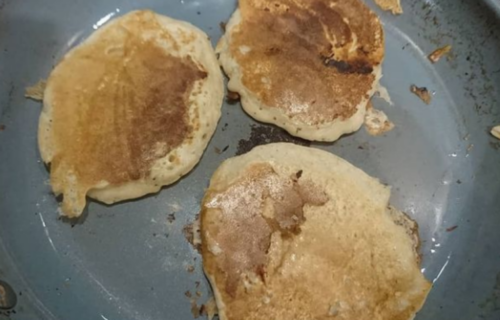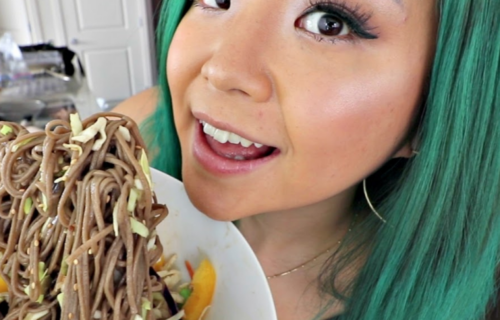Want to save money, have less food waste and perhaps lose a few inches around your waist all at the same time? Well it is fairly simple really – get your portion sizes right and you will always cook and eat the right amounts.
In the past I have never thought much about portion sizes and I almost always got it wrong. This meant too much food on my plate. This wasn’t good as I would either finish it – bad for my waist, or throw it away – unecessary waste!
Love Food Hate Waste is a great website full of lots of useful information about reducing food waste and there is very handy section on there detailing portion sizes. Also if you look on most packaged foods, they will tell you what a serving size should be. However, I feel it is worth looking at these as guidelines and spending a bit of time working out what portion sizes work best for you and your family.
 I have porridge every morning for breakfast and I used to just guess how much I needed and I could never make it through the bowl. Now I have worked out 1/3 of a cup (US measurement) of porridge with 2/3 cup water is perfect (I have a food intolerance to milk – doesn’t stop me eating icecream or chocolate though!).
I have porridge every morning for breakfast and I used to just guess how much I needed and I could never make it through the bowl. Now I have worked out 1/3 of a cup (US measurement) of porridge with 2/3 cup water is perfect (I have a food intolerance to milk – doesn’t stop me eating icecream or chocolate though!).
I have been experimenting with portion sizes for rice as well and haven’t quite got it right yet, as although I followed the serving suggestion on the packet I made far too much. The next time I made too little, so hopefully it will be third time lucky! I found it was easier to get the serving size of porridge right as it was just for me, whereas the rice was for myself, my husband and my two children, who some days eat more than we do and others just throw the lot on the floor (my 1 year old) or in the bin (my 3 year old).

There are various implements which can assist you in measuring out portion sizes. I have a set of measuring cups, measuring spoons, a measuring jug, and some electronic scales. Really though, you can use anything you have to hand such as spoons, mugs, glasses, milk bottles or jars, as long as the measurements are meaningful to you.
 There are special spaghetti measures out there that you can buy, which are essentially just holes to fit your spaghetti in. I’m sure it wouldn’t be too tricky to work out the diameter of a portion of spaghetti for one, or your whole family and make your own measure – but they aren’t too expensive to buy and a good quality one would last a lifetime.
There are special spaghetti measures out there that you can buy, which are essentially just holes to fit your spaghetti in. I’m sure it wouldn’t be too tricky to work out the diameter of a portion of spaghetti for one, or your whole family and make your own measure – but they aren’t too expensive to buy and a good quality one would last a lifetime.
How do you decide what portion sizes are right and what measures do you use? What do you do with the leftovers?
If you liked this article, I would really appreciate it if you like my blog on Facebook or follow me on Twitter.
Disclaimer: Affiliate links were used in this blog post.

 There are various implements which can assist you in measuring out portion sizes. I have a set of measuring cups, measuring spoons, a measuring jug, and some electronic scales. Really though, you can use anything you have to hand such as spoons, mugs, glasses, milk bottles or jars, as long as the measurements are meaningful to you.
There are various implements which can assist you in measuring out portion sizes. I have a set of measuring cups, measuring spoons, a measuring jug, and some electronic scales. Really though, you can use anything you have to hand such as spoons, mugs, glasses, milk bottles or jars, as long as the measurements are meaningful to you. 





Very useful, funny enough these are the types of foods that I do cook too much of. I then put in fridge promising to myself I'll use it later, about a WEEK or more later after its 'suffered' enough I shuck it :0( My bad. Very good post.
Thanks for your comment. If I cook too much rice, I often put it in the freezer for next time as I know I won't eat it in time…
What you need is a mummy sized portion, a daddy sized portion and a kid sized portion. Then you can all be happy. Good post, very informative.
That is very true! Thanks for the nice comments.
We work under the assumption that we are always going to have leftovers. Then we make sure to USE the leftovers for lunches and snacks, as ingredients in another meal, or as a "repeat" meal if there's enough for all of us.
Using smaller dishes can help you take a more reasonable portion and feel satisfied with it because it "looks like more."
A couple of years after I stopped growing taller, I realized that I was continuing to gain 10 pounds a year and this needed to stop before I got overweight. So I started to serve myself smaller portions and not take seconds. If I'm still hungry an hour later, I can have a snack. Works for me!
1. Set your fridge correctly
Extend the life of your food by making sure your fridge is between 1˚C and 5˚C (get a fridge thermometer to help you).
2. Check the cupboards
Plan your week’s meals before leaving home. Check your store cupboard and freezer to see what you need.
3. Ditch the fruit bowl
Store most fruit and veg in the fridge to make it last up to two weeks longer.
4. Use your freezer
Divide up large packs of chicken or fish and freeze as individual portions. Put leftover cooked food in freezer bags, label and freeze.
5. Check dates
Keep an eye on meat, fish and ready meals. If you don’t have time to eat them, move them into the freezer. Try using labels on food in the fridge to show when it needs eating by.
6. Understand the dates
‘Best before’ dates refer to quality (after this date, food won’t be at its best), while ‘use by’ dates relate to food safety (never eat products after this date). Learn more about labels at the Food Standards Agency.
Food tips
7. Only cook what you need
Measure out the right portions of pasta and rice. A mug filled with rice feeds four adults.
2. Blitz fruit
Turn very soft fruit into smoothies or purées to top breakfast cereal. Try our recipe finder for other drink recipes.
3. Freeze drinks
Pour the dregs of wine or beer into ice-cube trays or bags, freeze them and then use in stews and casseroles.
4. Make breadcrumbs
Whizz up stale bread, add herbs and spices and then use as a coating for chicken and fish.
Thanks for the helpful comments. Using smaller dishes is definitely a good idea!
Thanks for all the helpful hints and tips! I especially like the one about freezing beer and wine dregs for use in cooking!
This is a great way to save money and lose weight, thanks!
Great tips – thank you! I think those spaghetti measures are fab as I always cook way too much pasta. I can never seem to gauge it right. I'm the Queen of leftovers, in fact I quite like cooking too much as most stuff tastes better then next day!